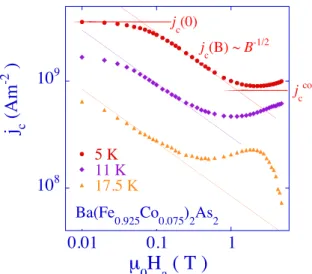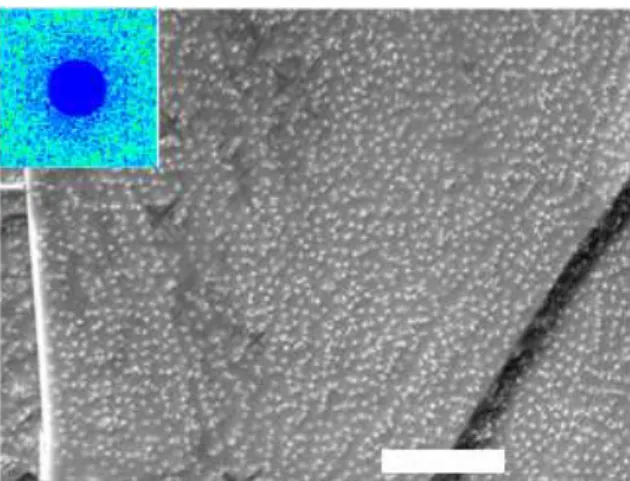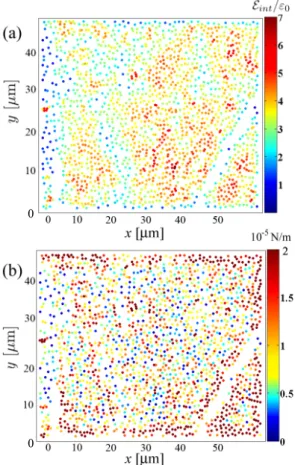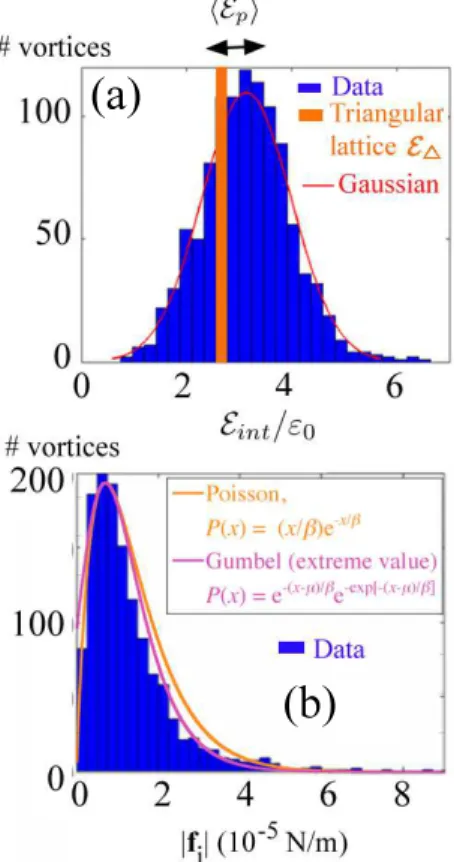HAL Id: hal-00625580
https://hal.archives-ouvertes.fr/hal-00625580
Submitted on 22 Sep 2011
HAL is a multi-disciplinary open access
archive for the deposit and dissemination of sci-entific research documents, whether they are pub-lished or not. The documents may come from teaching and research institutions in France or abroad, or from public or private research centers.
L’archive ouverte pluridisciplinaire HAL, est destinée au dépôt et à la diffusion de documents scientifiques de niveau recherche, publiés ou non, émanant des établissements d’enseignement et de recherche français ou étrangers, des laboratoires publics ou privés.
Vortex pinning : a probe for nanoscale disorder in
iron-based superconductors
Cornelis Jacominus van der Beek, Sultan Demirdis, Marcin Konczykowski,
Yanina Fasano, Nestor Cejas-Bolecek, H. Pastoriza, Dorothée Colson, F.
Rullier-Albenque
To cite this version:
Cornelis Jacominus van der Beek, Sultan Demirdis, Marcin Konczykowski, Yanina Fasano, Nestor Cejas-Bolecek, et al.. Vortex pinning : a probe for nanoscale disorder in iron-based superconductors. ECRYS 2011 - International School and Workshop on Electronic Crystals, Aug 2011, Cargèse, France. pp.00000, �10.1016/j.physb.2012.01.021�. �hal-00625580�
Vortex pinning : a probe for nanoscale disorder in iron-based
super-conductors
C.J van der Beeka,1 S. Demirdisa, M. Konczykowskia, Y. Fasanob, N.R. Cejas Bolecekb,
H. Pastorizab, D. Colsonc, F. Rullier-Albenquec a
Laboratoire des Solides Irradiés, CNRS-UMR 7642 & CEA-DSM-IRAMIS, Ecole Polytechnique, F 91128 PALAISEAU, France
b
Laboratorio de Bajas Temperaturas, Centro Atomico, Bariloche & Instituto Balseiro, Bariloche, Argentina
c
Service de Physique de l’Etat Condensé, CEA-DSM-IRAMIS, F 91198 Gif-sur-Yvette, France
1. Introduction
Quantifying the effects of material disorder is important for the understanding of the su-perconducting ground state of iron-based superconductors (IBS). On the one hand, the prox-imity of the superconducting state to anti-ferromagnetism may lead to phase segregation that will be heavily influenced, for example, by macroscopic heterogeneity of the chemical composition. On the other hand, the superconducting ground state in these materials was proposed to have a so-called s±symmetry [1,2], in which the superconducting gap not only
has a different value on different Fermi surface sheets, but may also change sign from one sheet to another. Then, superconductivity is thought to be exquisitely sensitive to interband scattering [3,4].
The effect of impurities is usually characterized by the scattering rate such as this can be extracted from resistivity measurements in the normal state, or from the surface resistance in the superconducting state. Another well-known but little exploited probe of microscopic disorder is the pinning of vortex lines in the superconducting mixed state. The radius of their core, of the order of the coherence length ξ ∼ 1.5 nm, makes vortices ideal probes for impurities. The fact that the vortex density can be easily varied by orders of magnitude simply by adjusting the value of the applied magnetic field Hamakes “vortex matter” sensitive
to local variations of material properties on different length scales. The bulk pinning force Fp exerted by the material disorder on the vortex ensemble inhibits the latter’s motion for
currents smaller than the critical current density jc = Fp/B. In the following, we analyze
vortex distributions and jc-data in IBS, show how these can be used to characterize the type
-4 106 -3 106 -2 106 -1 106 0 1 106 2 106 3 106 4 106 -4 -2 0 2 4 5.0 K 11.26 K 17.5 K M ( Am -1 ) µ 0Ha ( T ) Ba(Fe 1-xCox)2As2 x = 0.075
Fig. 1. Loops of the hysteretic magnetization M(Ha)versus the magnetic field Ha, measured on a Ba(Fe0.925Co0.0.075)2As2single
crystal, at different indicated temperatures.
2. Critical currents
Fig. 1 shows hysteresis loops of the irreversible magnetization M(Ha) versus the applied
magnetic field Ha, measured on a single crystal of Ba(Fe0.925Co0.075)2As2, with critical
temperature Tc = 23.5 K, using a commercial Superconducting Quantum Interference
De-vice magnetometer. As in all IBS, the hysteretic magnetic moment features a pronounced low–field maximum, superposed on a nearly field–independent contribution. A double-logarithmic plot of the critical current density as this follows from the Bean model [5], jc ∼ 3M/a (with a the crystal width), shows that the low–field maximum amounts to a
plateau jc(0), followed by a decrease jc(B) ∼ B−1/2. Such a behavior is naturally described
in terms of strong pinning by sparse, extrinsic defects of dimension greater than ξ, and density ni ≪ ξ−3[6,7]. The plateau–value
jc(0) ∼ (fp/√πΦ0ε)(Upni/ε0) 1/2
(1) and the decrease jc(B) ∼ (fp/Φ0ε)(Upni/ε0)(Φ0/B)
1/2can be parameterized in terms of the
elementary pinning force fpof a single strong defect, and the ratio of the energy Upgained by
placing a vortex on a defect to the vortex line energy ε0[8] (ε ≈ 0.4 is the material anisotropy
parameter [9] and Φ0 = h/2e is the flux quantum). Elimination of (Upni/ε0)
1/2directly yields
the experimental value fp = 3 × 10−13N at low T .
Further measurements were performed using the magneto-optical- [8,10] and Hall-array techniques [10,11]. The temperature dependence jc(0, T ), and that of the field-independent
contribution jcoll
c (T ) observed at fields exceeding ∼ 1 T is plotted in Fig. 3. In the following,
we first discuss the strong pinning contribution, before turning to jcoll
108 109 0.01 0.1 1 5 K 11 K 17.5 K Ba(Fe0.925Co0.075)2As2
µ
0H
a( T )
j c (A m -2 ) j c(0) j c(B) ~ B -1/2 jc(0) j c collFig. 2. Field-dependence of the critical current density jc∼ 3M/a (with a the crystal width), as extracted from Fig. 1.
3. Heterogeneity and strong pinning
Fig. 4 shows the vortex ensemble in single crystalline Ba(Fe0.9Co0.1)2As2 (with Tc = 19.5
K), at Ha = 10 G (1 mT). Vortex positions are revealed using Bitter decoration at 4.2 K, after
field-cooling through the superconducting transition [8]. The featureless Fourier transform of the set of vortex positions indicates the absence of long–range positional- or orientational order, and the presence of large fluctuations in the nearest-neighbor distance. The very dis-ordered vortex structure is the combined result of the narrow temperature trajectory over which it is frozen in during field-cooling and the importance of flux pinning at high T [8].
To characterize pinning, the vortex interaction energies, Ei int= P j(Φ 2 0/2πµ0λ 2 ab)K0(rij/λab),
and the force to which each vortex is subjected, fi =Pj(Φ 2 0/2πµ0λ 2 ab) (rij/|rij|) K1(rij/λab), 108 109 1010 0 5 10 15 20 25 Ba(Fe1-xCox)2As2 x = 0.075 Ha = 0 0.5 T 1 T 1.5 T 2 T Eq. (2) j c ( A m -2 ) T ( K ) j c(0) j c coll
Fig. 3. Temperature dependence of jcat different applied fields. Values for µ0Ha& 1 T are representative of j coll
c (T ). The drawn
line is a fit to Eq. (2), with σtr= 3Å 2
Fig. 4. Bitter decoration of vortices in a Ba(Fe0.9Co0.1)2As2 single crystal, for a field µ0Ha = 1 mT applied parallel to the
crystalline c-axis. The scale bar represents 10 µm. Inset: Fourier transform of vortex positions.
were determined from the inter-vortex distance ensemble {rij} (λabis the ab-plane
penetra-tion depth [12], and K0 and K1 are modified Bessel functions). The result is mapped out in
Fig. 5. The probability distribution of Ei
int, depicted in Fig. 6a, shows that the mean
inter-action energy hEi
inti exceeds the value E△ for vortices arranged in a triangular vortex lattice
of the same (average) density. Also, the distribution is considerably broadened with respect to the regular lattice δ-function. We interpret the Eint–distribution as being determined by
the contribution from the vortex pinning energy, with mean hEpi = hEinti − E△ ≈ 0.5ε0.
This large value of hEpi signifies that pinning cannot originate from well-defined defects
in a homogeneous superconducting matrix, but must be interpreted as arising from the heterogeneity of the superconducting properties of the material [8].
In order to verify whether such heterogeneity can account for jc, we turn to the distribution
of |fi|. Since the vortex system is at rest, Newton’s third law implies that the force map
(Fig. 5b) and the histogram of |fi| (Fig. 6b) are to be interpreted as representing the local
pinning forces fi acting on each vortex. The critical current density will be determined by
the average force hfii ∼ 5 × 10−6 Nm−1, rather than by the most strongly pinned vortices.
The effective pin density can now be estimated from the ratio of the pinning force per vortex, hfii, and the elementary force per pin, fp = 3 × 10−13 N determined above. This yields an
average distance between effective pins of 60 nm, and a pin density ni ∼ 5 × 1021 m−3 ≪
ξ−3. Strong pinning in Ba(Fe
1−xCox)2As2 must therefore be due to heterogeneity on the nm
scale. Substituting the obtained values in Eq. (1) reproduces the magnitude of jc, for a spatial
variance of the line energy ∆ε0/ε0 ≈ 0.05.
4. Quasiparticle scattering and weak pinning
The intermediate field (µ0Ha & 1 T) plateau of constant jc = jccoll is attributed to weak
collective pinning [13] by fluctuations of the dopant atom density nd ≫ ξ−3 at length scales
much less than the coherence length [15]. This contribution to pinning is found in all charge-doped IBS, as well as in Ru-charge-doped BaFe2As2 and FeSe1−xTex [14], but not in the P-doped
materials [15]. The magnitude and temperature dependence of jcoll
atom density fluctuations are effective through the variation of the quasi-particle mean free-path they entail [13,15,16]. In the field-regime where vortex lines are pinned independently from their neighbors (i.e. the “single-vortex regime” of collective pinning [13]), the resulting critical current contribution reads [15]
jccoll = √ Φ0 3µ0λ2abξ " 0.01ndσ 2 tr εξ ξ0 ξ !#2/3 (2) (with ξ0 = 1.35ξ the T –independent Bardeen-Cooper-Schrieffer coherence length). Fig. 3
shows that, after insertion of a quasi-particle transport scattering cross-section σtr ≈ 3 Å2
per Co ion, and of the λab(T )–dependence of Ref. [12], Eq. (2) also satisfactorily describes
both the magnitude and the T –dependence of the intermediate–field critical current density of our Ba(Fe1−xCox)2As2single crystals. The extracted value of the transport cross-section
can be related to the elastic quasiparticle mean-free path as l = (ndσtr)−1 ≈ 26 nm, to the
scattering phase angle as sin δ0 = (k 2
Fσtr/2π)1/2 ≈ 0.2, and to the quasiparticle scattering
rate Γ = nd[πN (0)]−1sin 2
δ0 ≈ 3 meV (here N(0) ∼ mkF/π 2
h2 is the normal state Density
of States and m is the electronic mass) [15].
5. Summary and conclusions
The bulk vortex pinning force Fp and the critical current density jc in single crystalline
Ba(Fe1−xCox)2As2 is representative of that found in other iron-based superconductors and
can be consistently described in terms of two additive contributions. At low magnetic fields, strong pinning by nm-scale variations of the vortex line energy (of the order of 5%) is the most relevant. Such variations may arise from the inhomogeneity of the gap [17] or from that of the superfluid density [12] . At higher fields, the effect of quasiparticle mean-free path variations due to spatial fluctuations of the dopant atom density is dominant.
References
[1] I.I. Mazin, D.J. Singh, M.D. Johannes, and M.H. Du, Phys. Rev. Lett. 101 (2008) 057003. [2] K. Kuroki et al., Phys. Rev. Lett. 101, 087004 (2008); ibid. , Phys. Rev. Lett. 102 (2009) 109902. [3] K. Kuroki, H. Usui, S. Onari, R. Arita, and H. Aoki, Phys. Rev. B 79 (2009) 224511.
[4] S. Onari and H. Kontani, Phys. Rev. Lett. 103 (2009) 177001. [5] E.H. Brandt, Phys. Rev. B 58 (1998) 6506.
[6] Yu. N. Ovchinnikov and B. I. Ivlev, Phys. Rev. B 43 (1991) 8024. [7] C.J. van der Beek et al., Phys. Rev. B 66 (2002) 024523. [8] S. Demirdiş et al., arXiv:1106.6065 (2011).
[9] J. Hänisch et al., IEEE Trans. Appl. Superc. 21 (2010) 2887. [10] C.J. van der Beek et al., Phys. Rev. B 81 (2010) 174517. [11] M. Konczykowski et al., arXiv:1108.5583 (2011).
Fig. 6. Histograms of the vortex interaction energy (a) and of the pinning force (b) distribution of Fig. 5. The first is well approximated by a Gaussian, while the force distribution (b) resembles a Poisson- or extreme value distribution. The energy distribution in (a) is compared to the δ-peak distribution for a (ordered) triangular vortex lattice of the same density.
[12] Lan Luan et al., Phys. Rev. Lett. 106 (2011) 067001. [13] G. Blatter et al., Rev. Mod. Phys. 66 (1994) 1125. [14] M. Konczykowski et al., to be published.
[15] C.J. van der Beek et al., Phys. Rev. Lett. 105 (2011) 267002.
[16] E.V. Thuneberg, J. Kurkijärvi, and D. Rainer, Phys. Rev. Lett. 48, 1853 (1982); Phys. Rev. B 29 (1984) 3913. [17] F. Massee et al., Phys. Rev. B 79 (2009) 220517.




